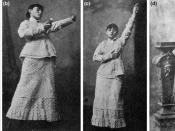"Acting As If You Are Hypnotized"ÃÂ by Nicholas Spanos, attempted to prove that "all behaviors commonly attributed to a hypnotic trance state are within the normal, voluntary abilities of humans. He believed that the only reason people define themselves as having been hypnotized is that they have interpreted their own behavior in ways that are consistent with their expectations. The article explains how Spanos devoted a decade of research prior to this article demonstrating how many of the effects commonly attributed to hypnotic trances could be explained just as easily in less mysterious ways. The shortcoming the article is the fact that it does not report on a specific experiment. Instead, it summarizes numerous studies made by Spanos and various others in the field. The studies were developed to defend Spanos's position against Hilgrad's contention. Spanos claimed that there are two key aspects of hypnosis that lead people to believe it is an altered state of consciousness.
One is that subjects view their behavior as being caused by something other than itself. The second aspect is the belief that the hypnosis ritual creates expectations in the subject which in turn motivate the subject to behave in ways that are consistent with the expectations. The research that he reported centered on frequent cited claims about hypnosis that have been drawn into question. The belief that behavior is involuntary was an important aspect of his tests. Spanos claimed that tests of the effectiveness of hypnosis forced subjects into believing things that were not actually occurring. Spanos interpreted these test suggestions as containing two closely related requests. One request asks subjects to do something, and the other asks them to interpret the action as having occurred involuntary/ some subjects fail completely to respond to the suggestion. Spanos's reasoning was that the subjects do not understand that they must voluntarily do something to initiate the suggested behavior and wait for their arms or body to begin to move. Other subjects responded to suggestions, but were aware that they were behaving voluntarily. Spanos concluded that whether subjects interpreted their behavior to be voluntary or involuntary depends on the way the suggestion is worded. In one specific study, Spanos placed two groups of subjects through a hypnosis introduction procedure. He gave one group various behavior suggestions, while the other group he gave direct instructions for the same behaviors. The conclusions was made that the subjects in the suggestion group were more likely to interpret their behaviors as involuntary than were those in the direct instruction group. Suggestions mad e to hypnotic subjects often ask them to imagine certain situations in order to produce a desired behavior. Spanos believed that some people may become absorbed in their "imaginal strategies"ÃÂ compared to others. Spanos found that when subjects were asked to rate how absorbed they were in a suggested imagined scenario, the higher the absorption rating, the more likely they were to interpret their related behavior ask occurring involuntarily. Implications of Spanos' findings can be interpreted in many ways. His goal was not to prove that hypnosis does not exist, but it was to demonstrate that what we call "hypnotic behaviors"ÃÂ are the result of highly motivated, goal-directed social behavior. It is now accepted among most scientists that people cannot be hypnotized against their will. Under hypnosis, subjects will not engage in acts they believe are antisocial, and they are not able to use superhuman strength or endurance. Recent applications of Spanos's studies were proved to be both right and wrong. In conclusion, Spanos was successful in proving his thesis, yet at the present time, might not be completely accurate.





